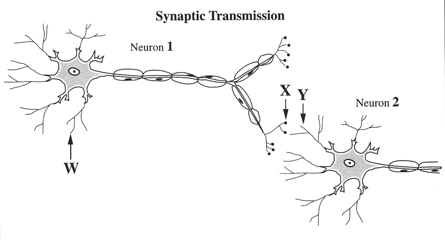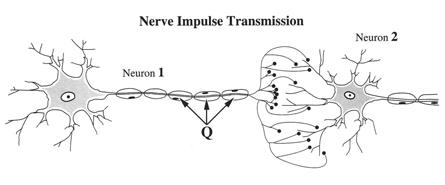Module 1
1. Module 1
1.58. Page 7
Module 1—The Nervous System
 Self-Check
Self-Check
Synaptic and neuromuscular transmitters are important and often challenging concepts to master. To ensure your understanding, complete the following Self-Check questions. The Self-Check is optional, but it is an excellent review and preparation for your lesson assignment that you will submit for assessment.
Use the following information to answer the next two questions.
| Avoiding a Collision
You are driving down a highway at night when a deer jumps in front of your vehicle. You slam on the brakes and avoid a collision. |
SC 10. Which row below best describes the initial reaction of your autonomic nervous system to this situation?
Row |
System Involved |
Neurotransmitter |
Response |
A. |
sympathetic nervous system |
norepinephrine | heart rate increases; pupils of eyes dilate |
B. |
parasympathetic nervous system |
acetylcholine | heart rate increases; pupils of eyes dilate |
C. |
sympathetic nervous system |
acetylcholine | heart rate increases; pupils of eyes constrict |
D. |
parasympathetic nervous system |
aorepinephrine | heart rate decreases; pupils of eyes constrict |
SC 11. Which row below best describes the reaction of your autonomic nervous system several minutes after the incident?
Row |
System Involved |
Neurotransmitter |
Response |
A. |
sympathetic nervous system |
norepinephrine | heart rate increases; pupils of eyes dilate |
B. |
parasympathetic nervous system |
norepinephrine | heart rate increases; pupils of eyes dilate |
C. |
sympathetic nervous system |
acetylcholine | heart rate decreases; pupils of eyes constrict |
D. |
parasympathetic nervous system |
acetylcholine | heart rate decreases; pupils of eyes constrict |
Use the following information to answer the next question.

SC 12. Destruction of the synaptic vesicles of Neuron 1 will
- block the nerve impulse at W
- cause X to be constantly stimulated
- prevent depolarization from occurring at Y
- result in the action of cholinesterase in Neuron 2
Use the following information to answer the next question.

SC 13. If the structures labelled Q were absent, what effect on neural transmission would be expected?
- The axon would not release acetylcholine.
- The axon would not become depolarized.
- The speed of transmission would be reduced.
- No action potential would arrive to release neurotransmitter.
Use the following information to answer the next question.
| The disease myasthenia gravis causes a person to experience muscular weakness because of the failure of neuromuscular junctions to transmit signals from nerve fibres to muscle fibres. The weakness is due to a reduced sensitivity to acetylcholine, which is necessary to stimulate the muscle fibre. People suffering from this disease are often treated with neostigmine, an anticholinesterase drug, which can result in some normal muscular activity within minutes.—Guyton and Hall, 1996 |
SC 14. Neostigmine is effective in treating this disease because it
- binds with cholinesterase to form acetylcholine
- binds with cholinesterase to increase acetylcholine production
- reduces the amount of active cholinesterase, thereby increasing the amount of acetylcholine available to stimulate muscle contraction
- increases the amount of active cholinesterase, thereby increasing the amount of acetylcholine available to stimulate muscle contraction
Use the following information to answer the next question.
Observations About a Synapse and Synaptic Transmission
|
SC 15. The assumption that axon terminals contain a limited amount of neurotransmitter could account for observation
- 1
- 2
- 3
- 4
Use the following information to answer the next question.
Alternative medicine, such as aromatherapy, is becoming increasingly popular in western society. Aromatherapy uses natural oils and plant extracts. The scents of the oils and extracts are inhaled or the fragrant oils are massaged into the skin. Proponents of aromatherapy hypothesize that odours affect the brain and its release of neurochemicals. These neurochemicals may then relieve pain.
Hypothesized Steps in Aromatherapy Action
|
Numerical Response
SC 16. If it is assumed that the hypothesis is correct, the order in which the steps above would occur to result in pain relief in a person having just inhaled the scent from an aromatherapy oil or extract is ______, ______, ______, and ______.
SC 17. While working in a lab, you accidentally mixed some unknown chemicals together and a vapour was produced, which diffused throughout the lab. Soon the lab animals in the room collapsed, unable to move. You made a quick examination of the animals and found their musculature to be very loose and relaxed. You concluded that the vapour became internalized in the animals by way of the lungs to the blood, which then distributed the vapour throughout the animals’ bodies. The symptoms shown by the lab animals may lead you to conclude that the vapour could have
- stimulated the action of the enzyme cholinesterase
- inhibited the production of acetylcholine by the axon endings of neurons
- inhibited the formation of synaptic transmission chemical produced by the dendrites
- stimulated the axon endings to secrete large amounts of acetylcholine
 Self-Check Answers
Self-Check Answers
SC 10. A
SC 11. D
SC 12. C
SC 13. C
SC 14. C
SC 15. C
SC 16. 2, 1, 4, 3
SC 17. B